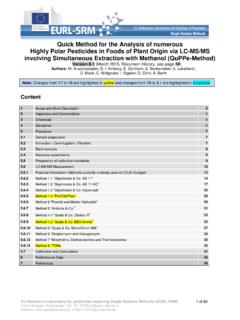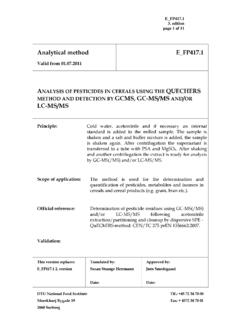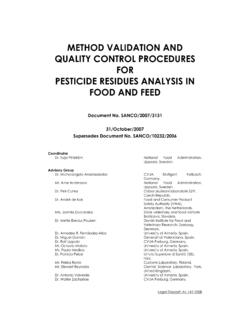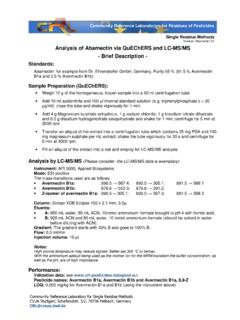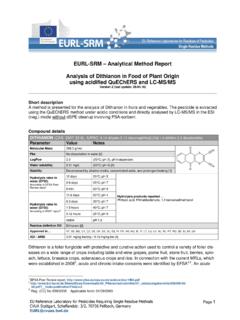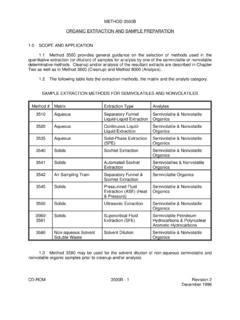Transcription of Quality Control Procedures for Pesticide Residues …
1 Page 1 of 30 Quality Control PROCEDURESFORPESTICIDE Residues ANALYSISG uidelines for Residues Monitoring in the European UnionSecond edition, 1999/2000 Page 2 of 30 Document No. SANCO/3103/2000 Prepared on behalf of the European Commissionby Alan Hill (UK) and the organising committee, following discussions at the2nd EU Workshop on Co-ordinated Analytical Quality Control , Athens, Greece, 15-17 November, 3 of 30 Quality Control Procedures FORPESTICIDE Residues ANALYSISI ntroduction1 This document describes analytical Quality Control (AQC) requirements tosupport the validity of data used for checking compliance with maximum residuelimits (MRLs), to support enforcement actions, or to assess consumer exposure topesticides. The objectives are (i) to ensure that false positives or false negativesare not reported, (ii) to ensure that acceptable accuracy (bias) and precision areachieved and (iii) to achieve harmonisation of cost-effective AQC in the options are provided, achievement of higher accuracy and precision willgenerally require application of the more stringent guidelines supersede document 7826/VI/97, also published as Annex IIof Commission Recommendation 1999/333/EC (Official Journal L128, ,21 May 1999) and as Annex II of EFTA Recommendation No.
2 153/99/KOL(Official Journal L74, , 2 July 1999).3 The glossary (Appendix 1) should be consulted for explanation of terms usedin the accordance with the provisions of Directive 93/99/EEC, laboratoryoperations should meet the requirements of a recognised accreditation scheme,complying with ISO 17025 or Good Laboratory Practice (GLP). The qualityrequirements described in this document are intended as guidance for accreditationpurposes. The accuracy and precision of weight and volume measurements mustbe consistent with achievement of the overall accuracy and precision requirementsof paragraphs , transport, processing and storage of samplesSampling5 Samples should be taken in accordance with Directive 79/700/EEC orsuperseding legislation.
3 Where it is impractical to take primary samples randomlywithin a lot, the method of sampling must be sample transportation6 Samples must be transported to the laboratory in clean containers and robustpackaging. Polythene bags, ventilated if appropriate, are acceptable for mostsamples but low-permeability bags ( nylon-film) must be used for samples to beanalysed for Residues of fumigants. Samples of commodities pre-packed for retailsale should not be removed from their packaging before transport. Very fragile orperishable products ( ripe raspberries) may have to be frozen to avoid spoilageand then transported in "dry ice" or similar, to avoid thawing in transit. Sampleswhich are frozen at the time of collection must be transported without which may be damaged by chilling ( bananas) must be protected fromboth high and low 4 of 307 Rapid transportation to the laboratory, preferably within one day, is essentialfor samples of most fresh products.
4 The condition of samples delivered to thelaboratory should approximate to that acceptable to a discerning purchaser,otherwise samples should normally be considered unfit for must be identified clearly and indelibly, in a way which preventsinadvertent loss or confusion of labelling. The use of marker pens containingorganic solvents should be avoided for labelling bags containing samples to beanalysed for fumigant preparation and processing prior to analysis9On receipt, each laboratory sample must be allocated a unique reference codeby the preparation, sample processing and sub-sampling to obtain testportions must take place before visible deterioration occurs. Canned, dried orsimilarly processed samples must be analysed within the stated shelf-life, unlessstored in deep preparation must be in accordance with the definition of thecommodity and the part(s) to be processing and storage Procedures should be demonstrated to have nosignificant effect on the Residues present in the test sample.
5 Where labile residuescould otherwise be lost, samples may be comminuted frozen ( in the presenceof "dry ice"). Where comminution is known to affect Residues ( or fumigants) and practical alternative Procedures are notavailable, the test portion should consist of whole units of the commodity, orsegments removed from large units. All analyses should be undertaken within theshortest time practicable, to minimise sample storage. Determination of very labileor volatile Residues should be started, and the Procedures involving potential loss ofanalyte completed, on the day of sample a single test portion is unlikely to be representative of the test sample,replicate portions must be analysed, to provide a reliable indication of the standards, calibration solutions, and purity of standards14 Pure standards of analytes and internal standards should be of known pure standard must be uniquely identified, the date of receipt recorded, andan expiry date allocated if the supplier has not provided this.
6 After the expiry date,a pure standard may be retained if its purity is shown to remain acceptable and anew expiry date is allocated. Otherwise it must be replaced. The relative purity ofthe new and old pure standards may be determined by comparing the detectorresponses obtained from freshly-prepared dilutions. Inexplicable differences inapparent concentration or identity between old and new pure standards must beinvestigated. Ideally, the identity of freshly acquired pure standards should bechecked if the analytes are new to the 5 of 3015At method development or validation, the response detected must be shown tobe due to the analyte, rather than to an impurity or artefact. If the techniques usedcan lead to degradation of the analyte during extraction, clean-up or separation, andthey generate a product which is commonly found in Residues but which isexcluded from the residue definition, positive results must be confirmed usingtechniques which avoid this of standards16 Pure standards should be stored according to the suppliers instructions(where given), to minimise degradation.
7 Generally, storage at low temperature(refrigerator or freezer) in the dark is satisfactory. The containers must be sealedto avoid entry of water, which is especially likely during equilibration to roomtemperature. If a pure standard changes visibly during storage it must not beused without checking the purity, unless the change is due to freezing and , use and storage of stock and working standards17 Preparation of stock and working standards (solutions, dispersions or gaseousdilutions) of pure standards of analytes and internal standards requires carefulattention to detail. Any inaccuracy in their preparation may not be apparent fromchecks of calibration or recovery but will directly affect the accuracy of theresidues data.
8 The identity and mass (or volume, for highly volatile compounds) ofthe pure standard, the identity of the solvent (or other diluent), and the volumesand dilution steps employed, must be recorded. Stock and working standards mustbe labelled indelibly. Concentrations must be corrected for the purity of the pure analyte (and internal standard) must not react with, and should haveadequate solubility in, the solvent(s) used to prepare solutions. The solvent(s) mustbe appropriate to the method of analysis and be compatible with the determinationsystem suitably accurate facilities are available, not less than 5-10 mg of the pure standard should be weighed. Volatile liquid analytes should be dispensedby weight or volume (if the density is known) directly into solvent.
9 Gaseous(fumigant) analytes may be dispensed by bubbling into solvent and weighing themass transferred, or by preparing gaseous dilutions ( with a gas-tight syringe,avoiding contact with reactive metals).20 Analyte solutions (or other dilutions) must be allocated an expiry date, afterwhich they should normally be discarded. Newly prepared stock standards shouldbe diluted (if necessary) and compared with those to be discarded. If the meanmeasurement for the new solution differs by more than 5% from the old one2, thenew solution should be checked for accuracy against a further newly prepared the number of replicate determinations required to distinguish a difference of 1 This requirement applies where the product of analytical degradation must be distinguished from thechemically identical metabolite in the sample, in order to determine the residue level according to thedefinition.
10 For example, 4,4 -dichlorobenzophenone from dicofol, tetrahydrophthalimide from captan andcaptafol, phthalimide from folpet, 2-chlorobenzonitrile from , a t-test of the means should not show a significant difference at the 5% 6 of 30 5% is unacceptably large for problematic analytes, the acceptable range may beincreased to 10%. If the old standard produces 95% (or 90% in the case ofproblematic analytes) of the response obtained from the new standard, the storageperiod for solutions must be shortened or the storage conditions improved. If theresponses from old and the new standards do not differ significantly, a longerstorage period may be considered. Aqueous suspensions of dithiocarbamates andsolutions (or gaseous dilutions) of highly volatile fumigants must be preparedfreshly.


